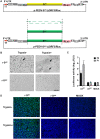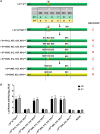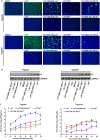Three Amino Acid Substitutions in the Spike Protein Enable the Coronavirus Porcine Epidemic Diarrhea Virus To Infect Vero Cells
- PMID: 36511700
- PMCID: PMC9927491
- DOI: 10.1128/spectrum.03872-22
Three Amino Acid Substitutions in the Spike Protein Enable the Coronavirus Porcine Epidemic Diarrhea Virus To Infect Vero Cells
Abstract
Porcine epidemic diarrhea virus (PEDV), a continuously evolving pathogen, causes severe diarrhea in piglets, with high mortality rates. To prevent or mitigate the disease, it is common practice to develop live or inactivated PEDV vaccines based on cell-adapted viral variants. Propagating wild-type PEDV in cultured cells is, however, often challenging due to the lack of knowledge about the requirements for the cell adaptation of PEDV. In the present study, by using the RNA-targeted reverse genetic system for PEDV to apply S protein swapping followed by the rescue of the recombinant viruses, three key amino acid mutations in the S protein, A605E, E633Q, and R891G, were identified, which enable attenuated PEDV strain DR13 (DR13att) to efficiently and productively infect Vero cells, in contrast to the parental DR13 strain (DR13par). The former two key mutations reside inside and in the vicinity of the receptor binding domain (RBD), respectively, while the latter occurs at the N-terminal end of the fusion peptide (FP). Besides the three key mutations, other mutations in the S protein further enhanced the infection efficiency of the recombinant viruses. We hypothesize that the three mutations changed PEDV tropism by altering the S2' cleavage site and the RBD structure. This study provides basic molecular insight into cell adaptation by PEDV, which is also relevant for vaccine design. IMPORTANCE Porcine epidemic diarrhea virus (PEDV) is a lethal pathogen for newborn piglets, and an efficient vaccine is needed urgently. However, propagating wild-type PEDV in cultured cells for vaccine development is still challenging due to the lack of knowledge about the mechanism of the cell adaptation of PEDV. In this study, we found that three amino acid mutations, A605E, E633Q, and R891G, in the spike protein of the Vero cell-adapted PEDV strain DR13att were critical for its cell adaptation. After analyzing the mutation sites in the spike protein, we hypothesize that the cell adaptation of DR13att was achieved by altering the S2' cleavage site and the RBD structure. This study provides new molecular insight into the mechanism of PEDV culture adaptation and new strategies for PEDV vaccine design.
Keywords: PEDV; S protein; cell adaptation; reverse genetics; tropism.
Conflict of interest statement
The authors declare no conflict of interest.
Figures





Similar articles
-
Development of a safe and broad-spectrum attenuated PEDV vaccine candidate by S2 subunit replacement.J Virol. 2024 Nov 19;98(11):e0042924. doi: 10.1128/jvi.00429-24. Epub 2024 Oct 15. J Virol. 2024. PMID: 39404450 Free PMC article.
-
Deletion of a 197-Amino-Acid Region in the N-Terminal Domain of Spike Protein Attenuates Porcine Epidemic Diarrhea Virus in Piglets.J Virol. 2017 Jun 26;91(14):e00227-17. doi: 10.1128/JVI.00227-17. Print 2017 Jul 15. J Virol. 2017. PMID: 28490591 Free PMC article.
-
Isolation and characterization of Chinese porcine epidemic diarrhea virus with novel mutations and deletions in the S gene.Vet Microbiol. 2018 Jul;221:81-89. doi: 10.1016/j.vetmic.2018.05.021. Epub 2018 Jun 6. Vet Microbiol. 2018. PMID: 29981713 Free PMC article.
-
Deciphering the biology of porcine epidemic diarrhea virus in the era of reverse genetics.Virus Res. 2016 Dec 2;226:152-171. doi: 10.1016/j.virusres.2016.05.003. Epub 2016 May 20. Virus Res. 2016. PMID: 27212685 Free PMC article. Review.
-
[Advances in reverse genetics to treat porcine epidemic diarrhea virus].Sheng Wu Gong Cheng Xue Bao. 2017 Feb 25;33(2):205-216. doi: 10.13345/j.cjb.160282. Sheng Wu Gong Cheng Xue Bao. 2017. PMID: 28956377 Review. Chinese.
Cited by
-
Clofazimine targeting the spike protein and RdRp exhibits highly efficient antiviral activity against porcine epidemic diarrhea virus in vitro.Virol Sin. 2025 Jun;40(3):477-490. doi: 10.1016/j.virs.2025.05.012. Epub 2025 Jun 1. Virol Sin. 2025. PMID: 40460916 Free PMC article.
-
Phylogenetic and Genetic Variation Analysis of Porcine Epidemic Diarrhea Virus in East Central China during 2020-2023.Animals (Basel). 2024 Jul 26;14(15):2185. doi: 10.3390/ani14152185. Animals (Basel). 2024. PMID: 39123710 Free PMC article.
-
Genomic Characterizations of Porcine Epidemic Diarrhea Viruses (PEDV) in Diarrheic Piglets and Clinically Healthy Adult Pigs from 2019 to 2022 in China.Animals (Basel). 2023 May 6;13(9):1562. doi: 10.3390/ani13091562. Animals (Basel). 2023. PMID: 37174599 Free PMC article.
-
Developing Next-Generation Live Attenuated Vaccines for Porcine Epidemic Diarrhea Using Reverse Genetic Techniques.Vaccines (Basel). 2024 May 19;12(5):557. doi: 10.3390/vaccines12050557. Vaccines (Basel). 2024. PMID: 38793808 Free PMC article. Review.
-
A Comprehensive View on the Protein Functions of Porcine Epidemic Diarrhea Virus.Genes (Basel). 2024 Jan 26;15(2):165. doi: 10.3390/genes15020165. Genes (Basel). 2024. PMID: 38397155 Free PMC article. Review.
References
-
- Sun J, Li Q, Shao C, Ma Y, He H, Jiang S, Zhou Y, Wu Y, Ba S, Shi L, Fang W, Wang X, Song H. 2018. Isolation and characterization of Chinese porcine epidemic diarrhea virus with novel mutations and deletions in the S gene. Vet Microbiol 221:81–89. doi:10.1016/j.vetmic.2018.05.021. - DOI - PMC - PubMed
Publication types
MeSH terms
Substances
LinkOut - more resources
Full Text Sources

